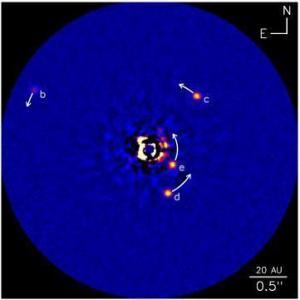Four gas giants, two fracture belts, sound familiar? Now we only need to discover the Earth and Mars of the same system

An international team of astronomers discovered and photographed a fourth giant planet around a solar system similar in its distribution of planets to our own solar system.
The study was published in the early online version of the journal Nature on December 8. Astronomers say, however, that this is an enlarged version of the solar system.
Besides the fact that both systems have four giant planets, both systems have two debris belts consisting of small objects or glaciers moving in orbit together with tiny particles," says Benjamin Zuckerman, UCLA professor of physics and astronomy and co-author of the article in Nature.
Our giant planets are Jupiter, Saturn Uron (Uranus) and Rahab (Neptune) and our debris belts include the asteroid belt between Mars and Jupiter and the Kuiper belt beyond the orbit of Rahab.
The newly discovered planet, HR 8799e orbits the star HR 8799 which is 129 light years away from Earth and barely visible to the naked eye. The total mass of this system is much greater than ours. Astronomers estimate that the combined mass of the four planets is 20 times greater than the total mass of all the planets in the solar system, and the debris bands also contain much more material than their counterparts here.
The new planet joins thethree discovered in 2008,The first multiple system discovered around another star. Four of the authors of the new study signed the study published in Science two years ago.
"This is the fourth imaged star in this system and only a small percentage of the known planets that have been discovered have also been imaged but no one has imaged a multi-planet system more than HR 8799." Zuckerman said. The interesting thing about this system is that all four planets are similar in size, between 5-7 Jupiter masses. The new planet orbits its sun at a closer distance than the other three. If it were placed in the solar system it would orbit it at a distance between Saturn and Oron.

4 תגובות
In my opinion, it is very worthwhile to start preparing for the possibilities of finding life, even life like a dog or a cat in these stars 🙂
Hostile or not, you never know what the future holds.
But it is better instead of sending to try to receive through initiatives like SETI.
My people, it is better not to reveal our location to hostile creatures, and there is a non-negligible chance that they are indeed hostile. First we have to leave the solar system and then see what kind of neighbors we have.
We need to start sending signals in the direction of these places. It will get there in a hundred years. Maybe then the technologies will be such that it will be possible to do something with it